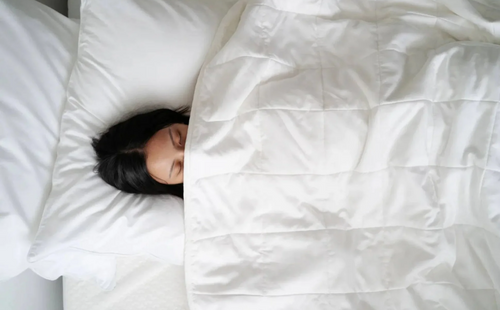At A Glance
This article explores the origins, advantages, and disadvantages of down duvets, comparing them with TENCEL™ Lyocell alternatives for durability, comfort, and sustainability.
Quick Tips
Choose hypoallergenic materials like TENCEL™ Lyocell or well-cleaned down if you're prone to allergies.
Note that down duvets need dry-cleaning, while TENCEL™ Lyocell can be machine washed.
Opt for TENCEL™ Lyocell for an ethical and eco-friendly option over traditional down.
Did you know that the term "duvet" comes from a French word that means down? Yes, that's how relevant down is in the bedding industry!
Historically, the classic duvet called a feather tick was mostly filled with the bigger feathers of birds and geese. A tightly woven pouch made from linen or cotton that was stuffed with down feathers and afterward stitched shut was known as a feather tick.
Over time, new fillings have come into existence but down duvet has always been recognized as one of, if not the best, when it comes to quality.

Featuring Weavve's TENCEL™ Lyocell Duvet
In this article, we will dissect if this notion holds true until today or if other materials can rightfully dethrone it. We will talk about the advantages and disadvantages of down duvets and whether it really is the best filling available in the market.
What Is A Down Bedding?
It is a type of material with feather fillings. It utilizes the insulation value of bird feathers. A goose or duck's inner, down-filled layer is found just below its outer, feathered layer. It is often collected from the bird's abdomen or chest region.
Compared to external feathers, down is considerably smaller, lighter, and plumper. There are no pointy quills on it either. Down also retains more heat than synthetic inserts because its main function is insulation.

Image By Magova From Pexels
There are Canadian and European down blankets, as well as Hungarian goose down. In comparison with ducks, geese have higher temperature down clumps with better fill capacity. This is due to the fact that geese are relatively bigger than ducks and have greater down clumps.
Is Down The Best Material?
In terms of durability, temperature-regulation, insulation, and softness, down is undeniably one to beat. It is one of the most efficient organic insulators along with TENCEL™ Lyocell, which offers roughly thrice as much warmth as other textile materials.

Image By Artem Podrez From Pexels
Down, being plush and also quite resilient, can provide maximum comfort. However, it still always points to preferences. Be sure to name all your top considerations when choosing a duvet to see if down hits all the boxes. We will further flesh out its pros and cons in the succeeding sections.
4 Benefits Of Using Down Duvets

Image By Andrea Piacquadio From Pexels
Better Temperature Control
The benchmark of insulation is high-standard goose down. Down is extremely light and incredibly warm, instantly trapping body heat. This makes goose down an excellent choice for anybody looking for impressive thermal management.
A more temperature-regulating material like TENCEL™ Lyocell is also a perfect option if you’re looking for something you can use throughout all seasons. It is ultra-cooling so you won’t have to worry about night sweats any day.
Unlike polyester and down, a TENCEL™ duvet is naturally temperature-regulating and more moisture-wicking to keep the body comfortable and dry when sleeping all year long. Extreme heat is swiftly removed for long-lasting cooling.
Improved Sleep Quality

Featuring Weavve's TENCEL™ Lyocell Duvet
When it comes to selecting a premium down bedding, what works for one individual may not work for the next. Examine your sleeper profile - such as sleeping posture, as well as any back or neck difficulties, and personal choices.
If you tend to suffer from back and neck aches, try veering away from heavy materials. You could get a lightweight and softer material by using a greater down-to-feather proportion. Note that a majority of blankets combine down and feathers to offer a suitable balance of heaviness and comfort, but this can affect the quality to some extent.
Most people also find the best duvet to have the appropriate temperature and cubic inches for their bed. With bigger clump sizes as compared to duck down, both Lyocell and European goose-down filling can deliver an unrivalled blend of fluffiness, comfort, and firmness.
Longer Lifespan

Image By Karolina Grabowska From Pexels
In the same way that thread count affects bedsheet quality, fillings impact the way a blanket feels, looks, and stands the test of time. A good quality European goose-down comforter should last longer and provide greater cosiness than alternative comforters.
A 100% down blanket is also feather-free, so no annoying feathers will escape throughout the night. Down fibres, with their puffy clumps, can effectively control temperature to allow you to sleep peacefully. Good-quality down clumps also have a long lifespan and should last for many years.
Hypoallergenic Nature

Image By Michelle Leman From Pexels
Just like TENCEL™ Lyocell stuffing, the composition of down filling determines its anti-allergenic characteristics. Feather threads, fractured feather quills, dirt, as well as other undesirables are not uncommon in bedding in which the down has been improperly cleaned or made, provoking the nighttime allergies that many people ascribe to the down material.
Combine your hypoallergenic blanket with high-quality bed sheets and pillow covers that safeguard against humidity, mould spores, and discolouration for the greatest anti-allergy quality bedding sets.
3 Disadvantages Of Using Down Duvets
Bird Allergies

Image By Cottonbro From Pexels
Unfortunately, some people with severe allergies can never indulge in soft down bedding even if they want to. If you are one of them or unsure whether you are allergic to these types of feathers, don't fret just yet.
The most effective option is to purchase a down alternative, such as TENCEL™ Lyocell. This semi-synthetic fibre is uniformly spherical, supple, and almost frictionless, making it perfect for sensitive skin.
Harder To Clean

Image By Rodnae Productions From Pexels
To keep its fluffiness, down blankets must be dry-cleaned. Regular laundry detergents damage the lofting properties that render down so puffy. When such properties are lost, the material ends up losing a lot of its heat-capture potential.
Unethical Methods
How these materials are manufactured always begs the question: Is down cruel? Even though the majority of the material is taken from birds after slaughtering, birds in reproductive flocks may be subjected to plucking every 6 weeks before being slaughtered.

Image By Flo Maderebner From Pexels
Since the primary source of TENCEL™ Lyocell fibre is entirely natural, it is also 100% ethical and sustainable bedding.
Higher Price Tag
A down material can cost significantly more than certain down-alternative variants of a similar bedding product. This is because the natural filling is sourced from genuine feathers.
While down substitutes cost less than a hundred dollars, a genuine down material may cost several hundred dollars.
Natural Vs Synthetic Duvet: Which Is Better?

Featuring Weavve's TENCEL™ Lyocell Duvet
Materials with natural or semisynthetic filling, such as down and TENCEL™, offer the finest insulator. Both are also lightweight and incredibly resilient, and offer the most comfort in a duvet, quilt, or comforter.
But it is important to note that TENCEL™ is known to be more cooling and moisture-wicking than down and synthetic fillings. They also reign supreme in terms of durability and sustainability.
If you're looking for a material with down-like quality but more sustainable and cooling, check out Weavve Home's duvet in Singapore.




































